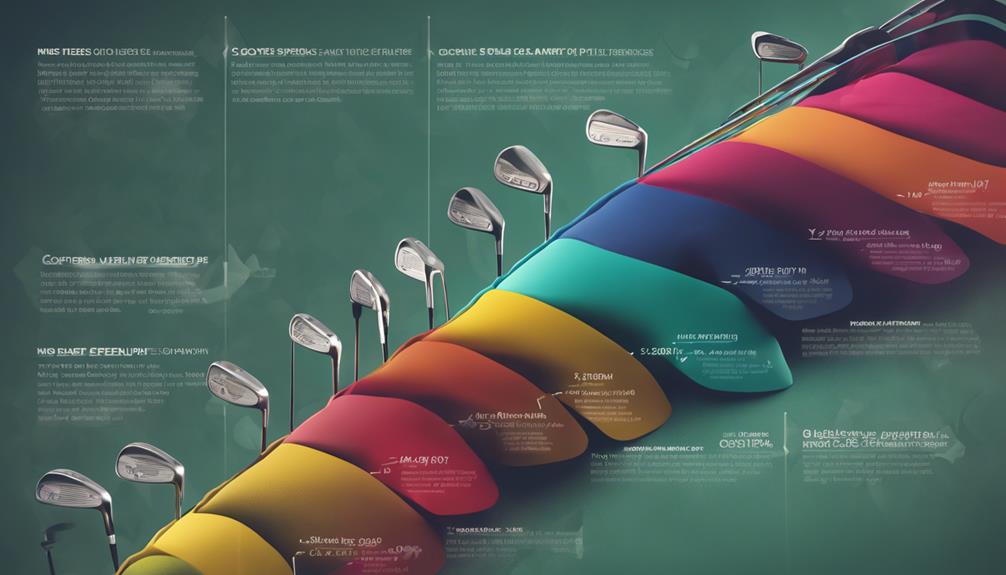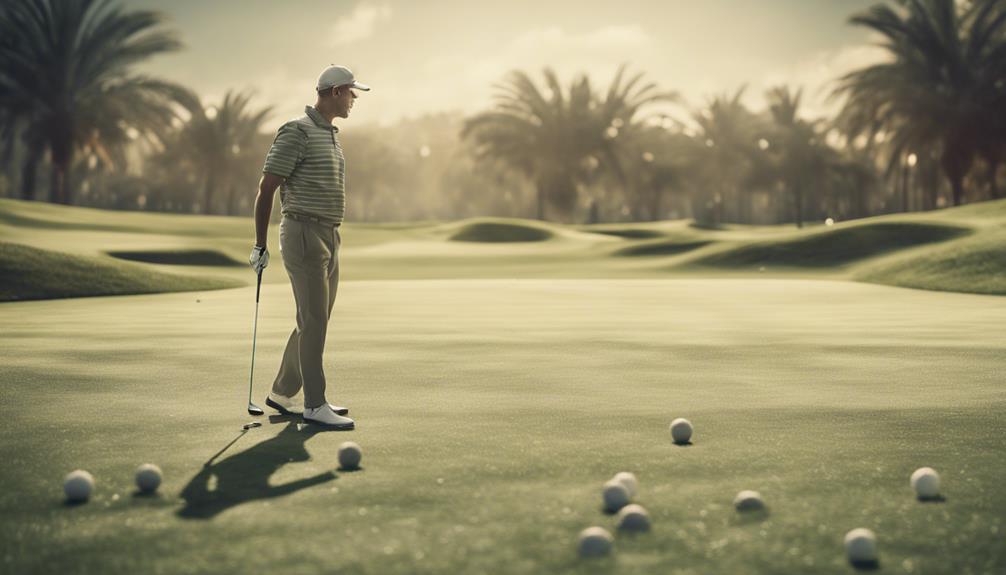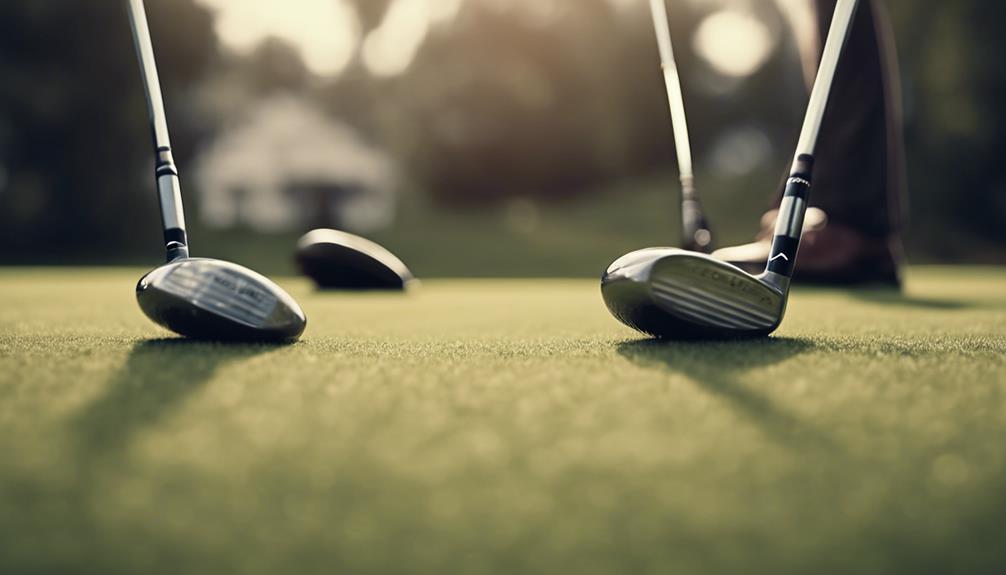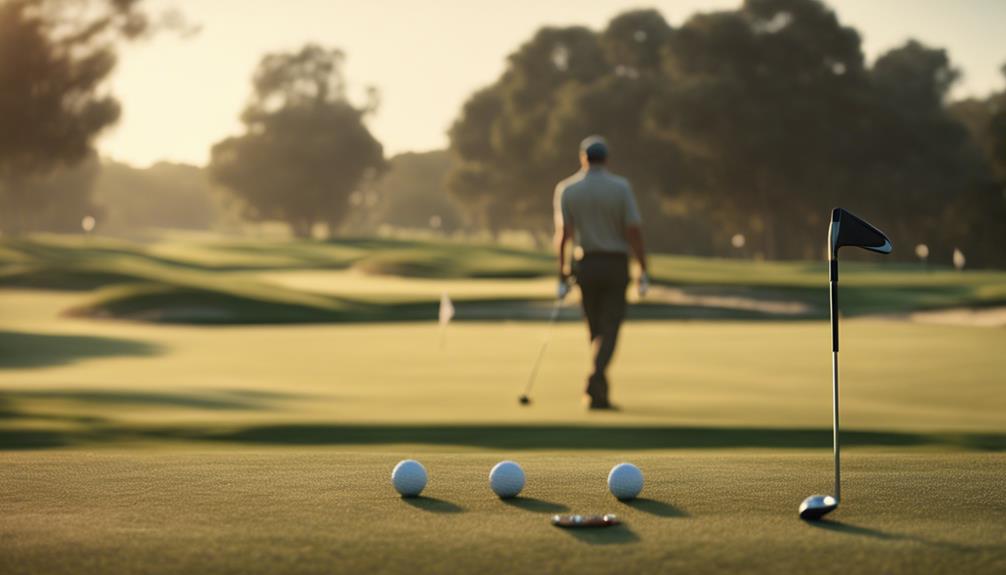- 7 Top Flite Golf Clubs XL for Improved Performance - September 28, 2024
- Top Flite Golf Clubs: Top 5 Reasons to Choose Them - September 28, 2024
- Top 3 Golf Club Fitters for a Perfect Swing - September 28, 2024
To master your game, you need to know the essential golf club distance charts. Drivers typically range from 230-260 yards, while fairway woods cover 215-235 yards for 3-woods and 190-210 yards for 5-woods. Irons vary from 170-185 yards for 4-iron to 150-160 yards for 6-iron, and wedges range from 105-120 yards for pitching to 60-70 yards for lob shots. Understanding these distances and how factors like swing speed, ball flight trajectory, and clubhead design impact them can substantially improve your game. Now, take a closer look at how to refine your club selection and trajectory to navigate the course with confidence.
Key Takeaways
- Average golf club distances vary by club type, with drivers ranging from 230-260 yards and wedges ranging from 60-120 yards.
- Understanding factors like swing speed, ball flight trajectory, and clubhead design helps optimize club selection and swing technique for desired distances.
- Loft is a critical factor in golf clubs, with higher loft resulting in shorter distances and lower loft resulting in longer distances.
- Documenting and regularly updating a personal golf club distance chart helps make data-driven decisions and improves club selection and overall performance.
- Developing a sense of club selection and trajectory through practice and charting distances builds confidence and avoids costly mistakes on the course.
Understanding Golf Club Distances
When you step up to the tee, understanding the complex interplay of factors that influence golf club distance is essential to selecting the right club for your shot and achieving the desired outcome.
A Club Distance Chart serves as a valuable resource in determining the distance each club is supposed to hit the ball.
However, it's vital to recognize that golf club distance depends on various factors, including swing speed, ball speed, smash factor, and clubhead speed.
Even with the same swing speed, varying distances can be achieved depending on the club's efficiency.
The maximum smash factor or efficiency is generally 1.5, calculated by dividing ball speed by clubhead speed.
By grasping these factors, you can accurately determine the average club distance and adjust your game accordingly.
Understanding the dynamics of golf club distance will help you optimize your club selection, leading to more accurate shots and improved overall performance.
Average Distances by Club Type
Your golf bag is stocked with a variety of clubs, each designed to achieve a specific distance, and understanding these average distances by club type is critical to selecting the right tool for the shot.
When it comes to driver distance, you can expect to hit the ball 230-260 yards on average, with pros reaching up to 300 yards or more.
Fairway woods are next, with 3-woods averaging 215-235 yards and 5-woods averaging 190-210 yards.
For irons, a 4-iron will typically travel 170-185 yards, a 5-iron will go 160-170 yards, and a 6-iron will reach 150-160 yards.
Wedges are where precision comes into play, with pitching wedges averaging 105-120 yards, gap wedges averaging 90-105 yards, sand wedges averaging 80-90 yards, and lob wedges averaging 60-70 yards.
Finally, hybrid clubs, which combine features of woods and irons, will typically travel 190-220 yards.
Having a solid grasp of these average distances will help you create a solid game plan and make informed club selections.
Golf Club Distance Chart by Swing Speed

When you're creating a golf club distance chart by swing speed, you'll need to take into account your swing characteristics, including your speed, tempo, and ball-striking ability.
As you examine the chart, you'll notice that slow swing speeds typically result in shorter distances, while faster swings yield longer shots.
Slow Swing Characteristics
With swing speeds ranging from 60-80 mph, golfers typically experience shorter distances for each club in their bag.
As a golfer with slow swing speeds, you can expect your drivers to travel around 150-170 yards, while your 7-irons will fly around 110-120 yards.
One key characteristic of slower swing speeds is a higher trajectory, leading to shorter rollouts and overall distances.
To compensate for this, you may benefit from using clubs with more loft and lighter shafts to increase distance and accuracy.
It's essential to understand that your club speed directly affects the distance you hit.
With slower swing speeds, you'll need to focus on optimizing your clubhead speed through exercises and training rather than trying to hit the ball harder.
Fairway woods can be particularly challenging with slow swing speeds, but by adjusting your club selection and technique, you can still achieve respectable distances.
By acknowledging your slower swing characteristics and making adjustments accordingly, you can improve your overall game and hit more consistent shots.
Mid-Range Distance Potential
Golfers who swing at a moderate pace of 75-85 mph can expect to achieve respectable distances across their bag, ranging from 180-200 yards with their driver to around 50-70 yards with their lob wedge. This mid-range swing speed allows for a consistent yard difference between clubs, making it easier to navigate the course.
| Golf Club | Average Distance (yards) |
|---|---|
| Driver | 180-200 |
| 3-Iron | 160-180 |
| 7-Iron | 90-110 |
| Lob Wedge | 50-70 |
With a mid-range swing speed, you can expect to hit your irons with precision, achieving distances of 120-140 yards with a 4-iron, 110-130 yards with a 5-iron, and 100-120 yards with a 6-iron. Your pitching wedge will reach around 80-100 yards, while your gap wedge and sand wedge will stop at around 70-90 yards and 60-80 yards, respectively. By understanding these average distances, you can fine-tune your game, adjusting your club head speed and swing technique to maximize your performance.
Fast Swing Expectations
You can expect a significant boost in distance across your bag if you swing at a fast pace, exceeding 100 mph, with drivers reaching up to 330 yards and irons stretching out to over 230 yards. As your swing speed increases, so does the distance your golf ball travels.
With a swing speed of 115 mph, you can reach distances of 290 yards with your driver, 240 yards with your 3-wood, and 200 yards with your 5-iron.
At 120 mph, your driver can reach 310 yards, your 3-wood 250 yards, and your 5-iron 215 yards.
And with a swing speed of 125 mph, you can expect to hit your driver 330 yards, your 3-wood 260 yards, and your 5-iron 230 yards.
These distances are achievable due to the increased ball speed generated by your fast swing speed. On the driving range, you'll notice a significant difference in your Distance For Male, allowing you to take aim at pins from farther away.
Average Golf Club Distances by Skill Level
As skill level increases, so does average distance, with beginners typically hitting shorter shots than more experienced players who can generate faster swing speeds. Your golf club distance is directly related to your skill level, and understanding this correlation is essential for improving your game.
| Handicap | Average Driver Distance (yards) |
|---|---|
| 0-5 | 230 (male), 170 (female), 200 (senior) |
| 11-15 | 200 (male), 150 (female), 180 (senior) |
| 16-20 | 180 (male), 130 (female), 160 (senior) |
According to research, the 50th percentile driver swing speed varies by age and gender. Male golfers average 93.4 mph, female golfers average 76.4 mph, and senior golfers average 84.5 mph. As you can see from the table above, the average driver distance increases with a lower handicap, demonstrating the direct impact of skill level on golf club distance. By understanding your average club distances, you can better assess your game and focus on improving your golfers' swing and driver swing speed to hit longer shots.
Factors Affecting Golf Club Distance

Swing speed, ball flight, and clubhead design are among the key factors that substantially influence the distance your golf ball travels, regardless of your skill level. When you swing the club, these factors come into play, affecting the distance the ball travels.
You should consider the following factors that can impact your golf club distance:
- Swing speed: Slower swing speeds will result in shorter distances. If you're looking to increase your distance, consider incorporating strength training into your fitness routine to boost your speed.
- Ball flight: The trajectory of your shot plays a significant role in determining the distance it travels. A higher launch angle can result in longer distances, while a lower launch angle will yield shorter distances.
- Clubhead design: The design of your clubhead, including its size, shape, and material, is an important factor in determining the distance the ball travels. Clubs with larger, lighter clubheads tend to produce longer distances.
Club Distance Charts for Men and Women
As you review the club distance charts, you'll notice distinct distance patterns for men and women.
For men, averages vary depending on swing speed, with drivers ranging from 230 to 300 yards and irons from 145 to 115 yards.
Meanwhile, women's distances are generally shorter, with drivers reaching 170 to 220 yards and irons spanning 110 to 90 yards.
Male Golfer Averages
You can expect your average driver distance to fall between 230-260 yards, with 3-wood shots typically carrying 215-235 yards and 4-iron shots reaching 170-185 yards.
As a male golfer, your swing speed plays a significant role in determining the distance you hit the ball. According to TPI research, the 50th percentile driver swing speed for male golfers is around 93.4 mph, which translates to a carry distance of approximately 214 yards.
7-iron: 140-150 yards
Pitching wedge: 100-110 yards
Sand wedge: 75-85 yards
As you refine your golf swing, you'll likely see an increase in driver distances. While beginners average around 195 yards, professionals on the PGA Tour can hit drives exceeding 280 yards.
Understanding your average golf club distances is essential to improving your game and making informed club selections. By mastering your swing and familiarizing yourself with these distance charts, you'll be well on your way to becoming a skilled golfer.
Female Golfer Averages
Female golfers, on average, can expect to hit their drivers around 170 yards, a notable difference from their male counterparts.
This shorter driver distance is largely due to a slower swing speed, which averages around 97 kmph for female golfers. In comparison, men's average swing speed is around 129 kmph.
When it comes to irons, you can expect to hit your 7-iron around 130 yards, about 20 yards shorter than men.
To compensate for the distance gap, women's golf clubs are designed to be lighter and have more loft, increasing distance and accuracy.
According to TPI research, the 50th percentile driver swing speed for female golfers is around 90 mph, markedly lower than the 114 mph average for male golfers on the PGA Tour.
Understanding your swing speed and the club you hit is vital in determining your golf club distance.
By knowing your average distances, you can make informed decisions on the course and improve your game.
As a female golfer, optimizing your performance and taking your game to the next level requires that you understand your strengths and weaknesses.
Importance of Loft in Golf Clubs

When choosing a golf club, one essential consideration is the loft, which plays a key role in determining the distance the ball will travel. The loft of a golf club is measured in degrees, and it's a critical factor in achieving the right distance and trajectory.
As you know, a higher loft results in a shorter distance, while a lower loft results in a longer distance.
Your swing speed determines the ideal loft for your clubs. Faster swing speeds require a lower loft, while slower swing speeds require a higher loft.
Loft also affects the trajectory of the ball, with higher lofted clubs producing a higher trajectory and lower lofted clubs producing a lower trajectory.
Understanding the loft of each club in your bag is essential for making informed shot decisions and improving overall performance.
How to Improve Golf Club Distance
Optimizing golf club distance requires a thorough understanding of the complex interplay between personal swing speed, ball speed, smash factor, and clubhead speed, as well as the impact of physiology, skill, age, and strength or flexibility levels on these factors. To improve your golf club distance, you need to focus on optimizing each of these areas.
| Area to Optimize | Impact on Distance | Improvement Strategies |
|---|---|---|
| Swing Speed | Higher swing speed = longer distance | Training, coaching, equipment fitting |
| Ball Speed | Faster ball speed = longer distance | Optimizing clubhead design, shaft material |
| Smash Factor | Maximum efficiency = 1.5 | Coaching, practice to hit sweet spot |
| Clubhead Speed | Faster clubhead speed = longer distance | Lighter shafts, optimized club design |
| Consistent Ball Striking | Consistent speed and direction = longer distance | Coaching, practice to develop muscle memory |
Documenting Your Club Distance Chart
You'll need to accurately document your golf club distance chart to track your progress and identify areas for improvement. This chart will serve as a valuable reference, helping you choose the right club for each shot and optimize your game.
To create an effective chart, you'll need to hit each club multiple times, measuring how far the ball travels on average. Be sure to record the results for every club in your golf bag, from driver to putter.
Average distance for each club should be included in your chart. Variance in distance should also be accounted for to cover different swing speeds and conditions. Notes on any trends or patterns you observe in your results are also important to include.
Using Golf Club Distance Charts Strategically
By consulting your personalized golf club distance chart, you can develop a more informed strategy for playing the course, making data-driven decisions to shave strokes off your score. With a clear understanding of how far each club will take you, you can choose the right club for every shot, avoiding costly mistakes and amateurish errors.
For instance, if you know your 7-iron consistently reaches 160 yards, you can confidently select it for a shot requiring that exact distance. This precision will help you maintain solid contact and optimize your golf equipment.
By using your chart strategically, you'll develop a better sense of club selection, trajectory, and spin, allowing you to navigate the course with confidence. Amateur golfers often struggle with club selection, but with a golf club distance chart, you'll be able to make informed decisions and take your game to the next level.
Refining Your Golf Club Distance Chart

To take your golf game to the next level, refining your personalized golf club distance chart is key, and it starts with precision tracking and recording of distances for each club, considering factors such as swing speed, ball speed, and smash factor.
This attention to detail will help you refine your club selection, leading to improved distance control and overall performance.
To refine your chart, focus on the following:
- Develop a consistent pre-shot routine to maintain focus and consistency in your swings, ensuring accurate distance tracking.
- Utilize launch monitors and swing speed radar devices to gather precise data on your swing speed, ball speed, and smash factor, helping you fine-tune your chart.
- Regularly update your chart to reflect changes in your playing style, environmental conditions, or equipment, ensuring your chart remains accurate and relevant.
Frequently Asked Questions
How Far Should a 60 Year Old Man Hit a 7 Iron?
As a senior golfer, you can expect to hit a 7-iron around 145-155 yards, depending on your swing speed, iron forgiveness, and fitness level, but age limitations and club loft will impact your distance expectations.
What Swing Speed Do You Need to Hit 250 Yards?
'Are you ready to tap into your inner beast on the course? To hit 250 yards, you'll need to crank up your clubhead speed to around 105 mph, mastering ball flight, swing tempo, and distance control to bridge the yardage gap – and speed training is key to getting you there.'
How Far Should a Man Hit a 7 Wood?
You hit a 7-wood around 185-190 yards, depending on your ball position, clubhead speed, and swing tempo. With premium shaft material, you can achieve a carry distance of 175-180 yards, ideal for fairway shots that require precision and control.
What Is the Best Way to Figure Out Golf Distances?
"As you navigate the green, you're on a mission to crack the code of precise distances. You'll find your answer by harnessing GPS tracking, laser rangefinders, course mapping, ball fitting, swing analysis, and yardage books to dial in your game."
Conclusion
As you fine-tune your game, remember that mastering golf club distances is a continuous process.
Like a puzzle, each club's distance is a piece that fits into your overall strategy.
With a solid understanding of average distances, factors that affect them, and how to improve, you'll be able to navigate the course with precision.
By documenting and refining your club distance chart, you'll tap into your full potential and take your game to new heights.




